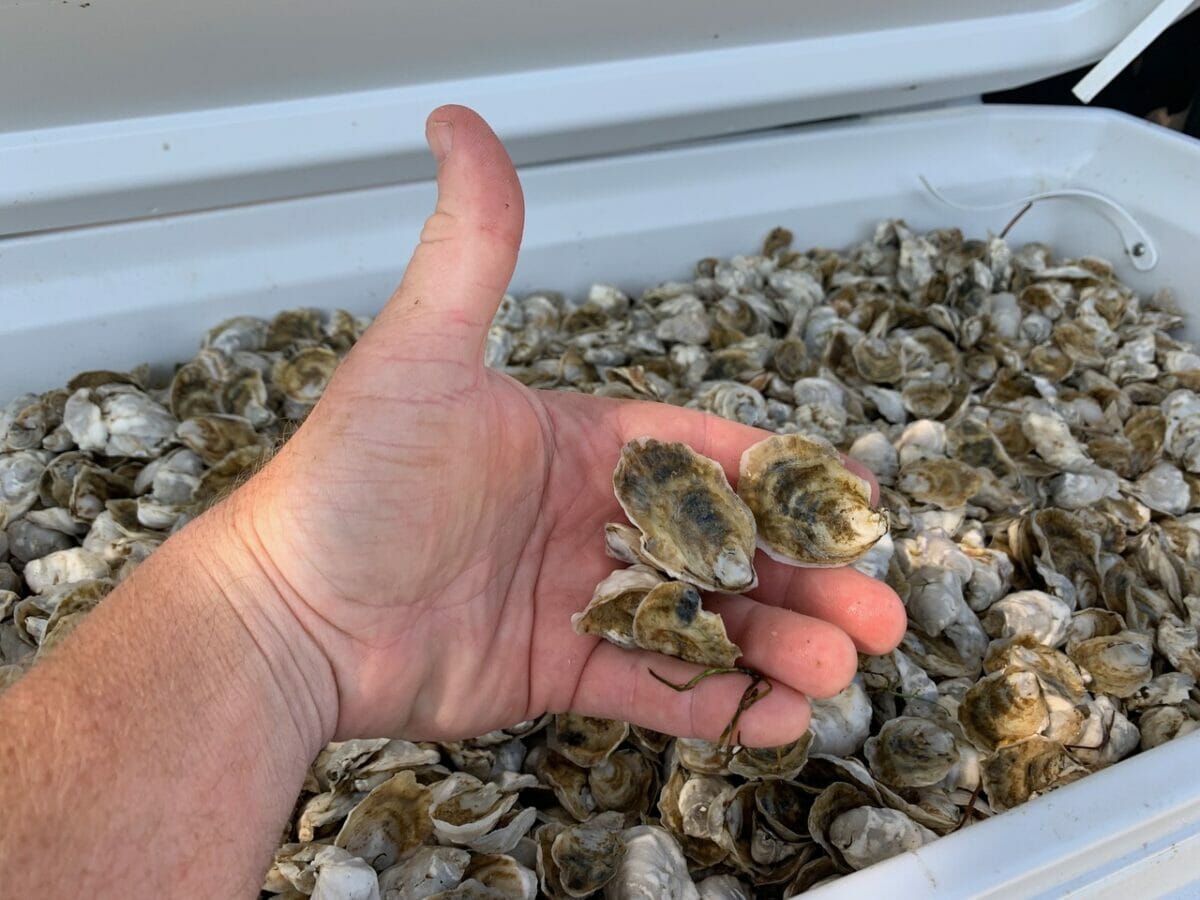Experts say bivalve aquaculture has the added benefit of restoring coastline.

Niels Lindquist grows seed oysters on 16 acres of shellfish leases, scattered along the North Carolina coast. He eschews floating traps, opting for “bottom leases” to grow oysters on the ocean floor and builds natural reefs in the process.
Lindquist is one of a growing number of oyster farmers whose businesses have the added benefit of helping restore the North Carolina coastline.
“There is a nexus between food production and trying to improve the environment,” says Lindquist, a co-founder of Sandbar Oyster Company and a professor of marine science at the University of North Carolina at Chapel Hill.
Between 2009 and 2016, the North Carolina Division of Marine Fisheries processed 81 oyster farm lease applications; the numbers have continued to rise, hitting 98 applications in 2017, 69 applications in 2018 (when numbers were down due to Hurricane Florence) and 106 applications in 2019. Conservation experts say this uptick in the number of shellfish farms on the North Carolina coast is good news for wild oysters and the environment.
Shellfish aquaculture or the farming of oysters, often in floating cages, helps protect wild oyster populations that have been historically overharvested.
“The growth of the shellfish aquaculture industry in North Carolina can benefit the economy and the environment if it’s done sustainably,” says Jacob Boyd, section chief, Habitat and Enhancement for the NC Division of Marine Fisheries.
From 1889 to 1908, annual harvests of wild oysters topped 500,000 bushels (with about 100 oysters per bushel), according to data from the North Carolina Coastal Federation but a combination of over-harvesting, habitat loss and diseases caused wild oyster populations to plummet to a low of nearly 34,500 bushels in 1994.
The numbers have started to rebound, as more than 119,000 bushels of wild and farmed oysters were harvested in 2018. The latest data shows that the harvest of farmed oysters has surpassed the wild harvest for the first time. Beth Darrow, chief scientist at Bald Head Island Conservancy, believes aquaculture has helped.
“Oyster farming is one of the most sustainable food production systems [and] provides a sustainable alternative to wild oyster harvest,” Darrow says. “It reduces the strain on wild oyster populations and allows them to rebound.”
Oysters also offer some big environmental benefits: the reefs act as natural breakwaters, protecting against sea level rise and storm surge, reducing erosion and improving water quality (a single oyster filters up to 50 gallons of water per day).
The North Carolina coast is particularly vulnerable to climate-related changes, including storm surges, coastal flooding and erosion. Oyster farms could help mitigate the damage, says Erin Fleckenstein, a coastal scientist and regional manager for North Carolina Coastal Federation.
“When you use oyster reef to protect from erosion in a living shoreline, the reefs…act as speed bumps for the waves and help to disperse the wave energy,” says Fleckenstein.

Photo courtesy of Scott Burrell.
Boyd notes that while oyster farms do provide environmental benefits for ecosystems, it is unclear if they are as beneficial as wild oyster populations for building reefs. More data is needed before a solid conclusion can be drawn, he adds.
“Shellfish farming is more temporary because of the harvest, but farmers always have oysters of different sizes in the water and that creates a benefit,” he adds.
A growing number of oyster farmers are also contributing to restoration projects.
These restoration projects have also helped sustain oyster farmers during the pandemic, as restaurants were closed and shellfish farmers were off from their biggest markets. As demand for fresh oysters fell, it increased concerns over the loss of jobs in the aquaculture industry and the potential for oyster prices to collapse.
In 2021, a new program, Supporting Oyster Aquaculture and Restoration (SOAR), was created to purchase 5 million farmed oysters to restore shellfish leases in 20 locations across the United States.
SOAR is operated through a partnership between the Nature Conservancy, the Pew Charitable Trusts, the National Oceanic and Atmospheric Administration and the US Department of Agriculture and is aimed at protecting the shellfish aquaculture industry while supporting the environment.
In North Carolina, the Department of Marine Fisheries introduced the Shellfish Lease Restoration Permit (SLRP) in April. The pandemic-inspired initiative recognized that farmers needed an outlet to sell their oysters and allowed farmers to sell oysters, not meant for human consumption, to restoration sites.
Lindquist was one of the first oyster farmers to receive a permit.
“Not all of the oysters a grower has in their crop are table ready; they might not be pretty, they might have grown too big…and that’s a portion of the crop that could be useful for restoration,” he says. “[Selling to a restoration site] helps farmers to diversify their markets and helps us get as many oysters back into estuaries as we can.”
Every farmed oyster that goes into the water—even if it’s not used in a restoration site—provides important ecosystem benefits and Lindquist hopes that as oyster farming increases on the North Carolina coast, shellfish aquaculture will be viewed as a beneficial coastal industry.
“You can view oyster farms as restoration sites,” he says. “[Oyster farming] can generate a tremendous amount of high quality food…and have a lot of environmental benefits as well.”
I live in Mooresville NC 28117 and would like to be advised as to where ( what Supermarket) I could expect to find these Local North Carolina Oysters?